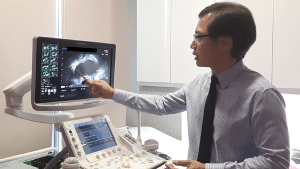The pelvis is a complex space where different organs, structures, nerves, blood vessels, muscles, fascia and ligaments come together. Like a city with roads, buildings, sewage, pipes, cables, communications etc, each organ and structure in your body will need to be functioning properly to have the environment in an optimal condition. Impairment of one structure may affect the functional status of another.
Just like the maintenance of a city needs engineers, architects, builders etc, the treatment of complex endometriosis will also need different specialities such as the endometriosis specialist, colorectal surgeon, urologist, fertility specialist, pain specialist, physiotherapist and so on.
Starting endometriosis treatment on the right foot
The first step in the treatment of endometriosis is a comprehensive assessment of the symptoms and extent of the disease. The endometriosis specialist will check for menstrual, bowel, urinary and functional symptoms, and then a physical and ultrasound examination will follow.
 The ultrasound will probably be the most insightful in terms of “staging” the disease. It should be able to:
The ultrasound will probably be the most insightful in terms of “staging” the disease. It should be able to:
- Identify the organs and structures affected by endometriosis and the extent
- Detect deep infiltrating endometriosis (DIE) and the depth/volume of DIE nodules within the pelvis. If DIE is not adequately assessed, there is a possibility of under treatment. The outcome may be persistence of symptoms which can be frustrating for the woman.
In 2016, the International Deep Endometriosis Analysis group published a consensus opinion on sonographic features of the different types of endometriosis. An exciting advancement in the management of endometriosis is the use of transvaginal ultrasound for endometriosis mapping.
How is your unique endometriosis map generated?
What endometriosis mapping means is essentially drawing a road map of the pelvis, marking out the location(s), depth and size of the endometriosis, hence revealing the severity and stage of endometriosis and telling us which organs and structures are affected by endometriosis.
Endometriosis mapping is performed via transvaginal ultrasonography, which means an ultrasound probe is inserted into the vagina to visualise the pelvic organs and structures. This is an essential step in looking at the relationship between different organs.

The scan can be done in the gynaecologist’s clinic and in any phase of the menstrual cycle. There is minimal discomfort to the woman as the endometriosis specialist performing the scan will be very gentle as he/she needs to ascertain specific areas for tenderness. The scan usually takes about 30 to 40 minutes, and allows the woman to see the areas being assessed while the specialist conducts the scan. In this way, the woman can also understand her disease process and severity during the scan from the doctor.
There is minimal preparation required before the scan, except for emptying the rectum before the scan (thus, some patients might be given medication to allow them to pass motion prior). Cost-wise, a transvaginal ultrasound is about $160-200, less than 20% of the cost of a basic MRI scan, which is another often-used imaging method to assess deeply infiltrating endometriosis.
Using your Endometriosis map to plan treatment
 Once the extent/stage and severity of the endometriosis has been established, treatment planning can start. This may involve different specialists, which is coordinated by the endometriosis specialist. It is crucial to involve the patient in treatment planning, and the aim is to take a long term view of the condition taking into account the symptoms, quality of life, fertility and extent of disease.
Once the extent/stage and severity of the endometriosis has been established, treatment planning can start. This may involve different specialists, which is coordinated by the endometriosis specialist. It is crucial to involve the patient in treatment planning, and the aim is to take a long term view of the condition taking into account the symptoms, quality of life, fertility and extent of disease.
It is the consensus of many top endometriosis centres that the first surgery for any endometriosis patient should be the best, and also hopefully the last, that she will need.
With a proper and accurate endometriosis map, the attending specialists can better ascertain the level of difficulty of the surgery required, and thus reduce the chances of leaving behind a lot of residual disease after the operation. When a lot of residual endometriosis is left behind, it often leads to incomplete resolution or persistence of symptoms, a higher chance of recurrence, and can also adversely affect ovarian reserve. A part of treatment may not be able to proceed since there had not been prior input from other specialists as well.
Conclusion
Endometriosis is not just a simple disease that affects the ovaries, or even just other parts of the body. It can be considered a complex and chronic disease, with significant impact on the woman’s physical and emotional well being, and even on her spouse/family and social circles such as friends, work and school.
With the far-ranging and long term impact that endometriosis can have on women across their reproductive years, it is imperative to take a closer and harder look at treatment, for both doctors and patients alike. And that begins with the first step of diagnosis.
Accurate endometriosis mapping is now possible with transvaginal ultrasonography performed by an experienced endometriosis specialist. What this translates to, for a woman suffering from the symptoms of endometriosis, is better treatment planning for improved treatment outcomes, and therefore a better quality of life.
- Part 1: The Different Faces of Endometriosis
- Part 2: What Your Ultrasound Scan Says About Your Endometriosis
- Part 3: Why Do Endometriosis Symptoms Continue After Treatment
- Part 4: Your Unique Endometriosis Map – An Important Tool for Treatment



